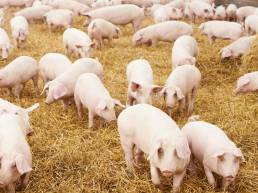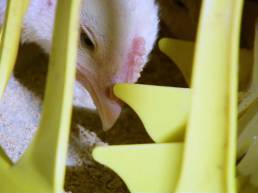Dysantic and Herbanoplex support healthy intestinal flora in pigs and poultry
Large scale and efficient livestock production requires a different approach. The focus is no longer on the treatment of diseases. Instead, achieving a healthy balance between protection and pathogens is key, with a specific focus on supporting the animal’s own immune system. Not all stress factors to which animals are exposed can be prevented. However, the impact of stress on animals can be reduced by ensuring the rapid recovery of the microbial balance in the gut.
Antipathogenic properties
There are many recognised natural molecules with proven antioxidant, antibacterial or immune modulating properties. When it comes to scientifically proven, target-specific antipathogenic properties, E.F.S. Holland has two powerful products in its range, Herbanoplex and Dysantic. Herbanoplex has been developed for poultry, and targets the microorganism Clostridium perfringens; Dysantic has been developed for pigs and targets the Brachyspira bacteria. The mechanism of action has undergone extensive research – the results speak for themselves. The active molecules act very selectively, penetrating the target microorganisms and destroying them. Naturally, other harmful bacteria like Streptococcus and Lawsonia are also targeted and eliminated, even at a relatively low dosage. To disrupt the activity of beneficial and desired bacteria, such as Lactobacillus and Lactococcus, the dosage needs to be on average fifteen times higher than recommended. The application of these phytogenic products is based on prophylactic use.
Microbial test serves as final product check
Natural substances provide the starting point for the synergistic combinations used for the creation of phenolic compounds. No chemicals, synthetic or nature identical substances are involved. The quality of each batch is tested extensively using the plate count method. In the microbial laboratory, the final product is brought into contact with the target microorganism. The aim of this process is to determine product efficacy. This provides a clear indication that the pathogen has no chance of colonising the intestinal wall. Thermostability can also be determined via the same in-house microbial analysis. After all, the product must be able to show the same powerful effect in practical situations after undergoing a heating process in the feed production facility.
Chain reaction
When directly targeting pathogens, many localised advantages indirectly occur which benefit a healthy gut. For example, there is an increase in the physical space on which healthy bacteria can settle on intestinal surfaces. Healthy bacteria are then able to produce fatty acids and a wide range of inhibitory substances (postbiotics). This has a positive effect on the depths of the crypts and heights of the villi. Together, they are responsible for the absorption surface area required for efficient nutrient uptake. Trials have shown that both Herbanoplex and Dysantic have a beneficial effect on mucus thickness. The continuous production and renewal of mucus cleanses and actively upgrades the immune system. The active control of virulent strains of pathogenic gut inhabitants by phytogenic molecules also results in a significant reduction in occurrences of gut inflammation. A desired animal-specific chain reaction is initiated in the inhibition of pathogen growth. Designed to stimulate and support good animal health from the start. Here, the same mantra applies: prevention is better than cure.
You may also like
Dysantic® special
May 25, 2020
The Netherlands plays a leading role in the reduction of antibiotics use in the feed sector. In 2022 the new EU regulation 2019/6 will come into force. This regulation stipulates the end of the preventive use of…
Herbanoplex and broiler chicks
April 7, 2019
Herbanoplex™ is a mixture of especially selected phytogenic products and has been developed to support the intestinal flora of poultry and boost the immune system against unfavourable bacteria.
New: Dysantic® and Herbanoplex™
June 7, 2018
As of 1 March E.F.S. has two new animal health improving products in its portfolio. Reason for this addition is the need for a reduction of antibiotics use in the EU. In recent years, on balance, the use has already…






